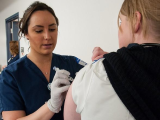Aug 22, 2011 (CIDRAP News) – A national group that represents infection control experts said today that a recent report from the US Centers for Disease Control and Prevention (CDC) documenting low flu vaccination rates among healthcare workers raises patient safety concerns.
The Society for Healthcare Epidemiology of America (SHEA) said in statement e-mailed to journalists that vaccination of healthcare personnel is a professional and ethical responsibility and that the latest findings prompted it to reissue a 2010 position paper recommending mandatory flu vaccination for healthcare workers.
In a report on flu vaccine uptake among healthcare workers during the 2010-11 flu season, the CDC said 63.5% were immunized, a small increase from 61.9% reported the previous season. The findings were based on an online survey of 1,931 healthcare workers that was conducted in April and appeared alongside the CDC's latest flu vaccine recommendations in the Aug 18 issue of Morbidity and Mortality Weekly Report (MMWR).
The survey revealed that workers such as physicians and nurse practitioners who had the most direct contact patients were more likely to be vaccinated against influenza and that coverage was high (98.1%) in facilities that had mandatory flu vaccination requirements. Workers who weren't subject to mandatory vaccination said they were more likely to be immunized if the vaccine were offered free, on site, and for an extended period.
Steve Gordon, MD, president of SHEA, said in the statement that healthcare providers are ethically obligated to receive the vaccine to prevent flu spread to patients, fellow workers, and themselves. "The data from the CDC's study demonstrated the effectiveness of policies that makes vaccination a requirement for employment," he said.
SHEA said that, alongside mandatory vaccination, it supports a comprehensive program to prevent the spread of flu in healthcare settings, including identifying and isolating infected patients, following hand hygiene and cough etiquette, using protective equipment, and restricting sick workers and visitors from healthcare facilities.
The group also highlighted strategies that can increase flu vaccination rates in healthcare workers, some of which were detailed in its journal, Infection Control and Hospital Epidemiology. For example, a July study from researchers at Geisinger Health System in Pennsylvania reported a 92% flu vaccination rate from a flu vaccination policy that stopped short of a mandate but required unvaccinated employees to wear a surgical mask when they were within 6 feet of a patient.
In the June issue, researchers from University Health System in San Antonio, Tex., raised their flu vaccine coverage level from 59% to 77% in 1 year without a mandatory policy by incorporating new tools such as supplying individual units with vaccine kits, conducting grand rounds presentations, enhancing staff awareness, and including a dashboard of each unit's vaccination rate on the staff intranet.
Though some health systems and facilities have instituted mandatory flu vaccination policies for employees, legal challenges have stalled some efforts. For example, in 2009 a lawsuit by a large healthcare worker union in New York was one factor that derailed a state requirement that the workers get flu shots. The state suspended the requirement before the court hearing because of a shortage of 2009 H1N1 vaccine.
In 2010 the Infectious Diseases Society of America (IDSA) formally asked federal health officials to recommend making influenza vaccination mandatory for healthcare workers.
The United States and other nations have put an emphasis on flu vaccination for healthcare workers as a tool for protecting patients and keeping staff healthy and on the job. During the 2009 H1N1 pandemic, federal officials put healthcare workers among the high-priority groups to receive the vaccine
However, the effectiveness of flu vaccines is below that of many other immunizations, such as measles. The inactivated flu vaccine is thought to be 70% to 90% effective in preventing flu in healthy, nonelderly adults when the vaccine and circulating viruses are well-matched, though studies have shown that the effectiveness can be significantly lower in people older than 65 and in seasons when the vaccine and circulating strains don't match well.
See also:
Oct 2010 SHEA position statement
Aug 19 MMWR report
July Infect Control Hosp Epidemiol abstract
June Infect Control Hosp Epidemiol abstract
Jul 16, 2010, CIDRAP News story "IDSA urges mandatory flu shots for health workers"





















